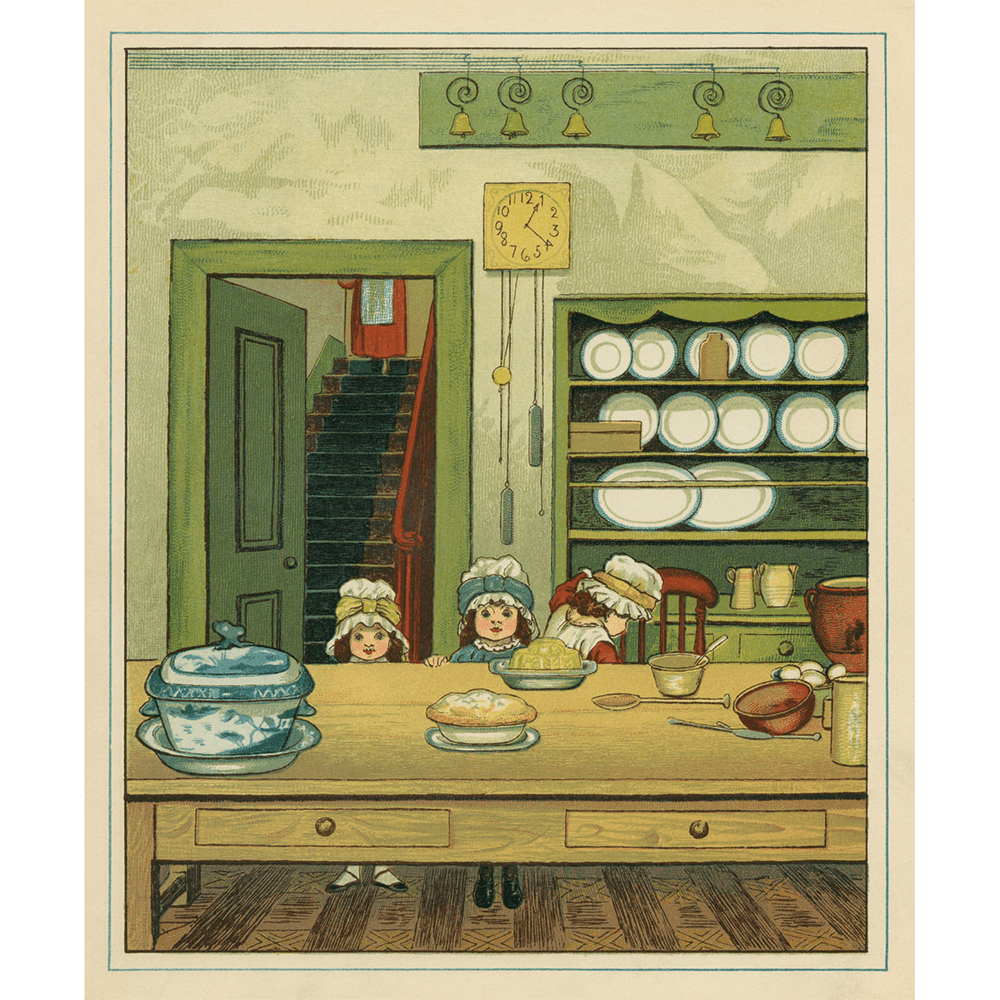There’s something wickedly entertaining in reading about other people’s kitchen debacles, whether actual or fictional. They’re just so relatable. The jelly that won’t jell in Louisa May Alcott’s Good Wives is cruelly hilarious, but the best culinary catastrophe in classic fiction, for my money, is in Anne of Green Gables.
Stylish guests, including the upper-crust Mrs. Chester Ross, are dining at Green Gables and our ebullient Anne is on her very best behavior. All goes well until Marilla arrives with the pudding and a pitcher of pudding sauce.
On spotting the pudding sauce, our heroine’s eyes grow wide and terrified. In awful technicolor, recent events replay before her: how days ago, instructed to cover the sauce in the pantry, she forgot; how the next morning, remembering, she came back, only to find floating in it a mouse which had raided its last larder. How, horrified, she fished out the deceased with a spoon, disposed of the corpse and gave the spoon a thorough scrubbing, but forgot all about the contaminated sauce – until the fateful moment when Marilla carries it in, warmed up, to serve their ritzy guests with the dessert.
Throwing caution to the wind, Anne rises in her place and shrieks before the assembled company, “Marilla, you mustn’t use that pudding sauce. There was a mouse drowned in it. I forgot to tell you before.”
The silence that descends is punctuated only by the look Mrs. Chester Ross gives Anne and the fiery complexion of Marilla, whisking away the pudding sauce.
The joy of this vignette is that it goes beyond a simple food flop into the realm of social irony. We don’t just have a mishap; we get to be onlookers as several different kinds of mishap occur in quick succession, under the horrified and ritzy nose of Mrs. Chester Ross. Why this situation, doubtless excruciating for its main actors, should be so entertaining for everyone else, remains one of the little mysteries of human nature.
In late-Victorian Prince Edward Island, creatures in the food are a decided solecism. “Are you sure there ain’t a spider in that cream jug, Kate?” inquires the catty Cousin Ernestine in Anne of Windy Poplars. “I’m afraid I saw one when you poured my cup.” “We never have spiders in our cream jugs,” is the ominous response, and the kitchen door slams. How different from the social setting aboard ship with Patrick O’Brien in the Georgian era, where the lesser of two weevils, emerging from the crumbs of the captain’s meal, is appreciated and praised.
Better-known in Anne of Green Gables is the disaster of the liniment cake. Anne, eager to impress the new minister’s wife who’s coming to tea, bakes a vanilla layer cake that is, to all external appearances, a showstopper.
Unseen in the background, however, Fate is quietly slipping lead into the boxing gloves (not my own expression; P.G. Wodehouse’s). The vanilla jar from which Anne poured the cake’s flavoring had been refilled with anodyne liniment, a vile-tasting herbal remedy. Anyone who’s been convinced to try Buckley’s Syrups (advertised as “the taste people love to hate”) will probably sympathize with the feelings of the poor minister’s wife, adjured to try a slice as Anne had made it especially for her. She can’t keep a poker face and the truth comes out, to Anne’s extreme embarrassment.
Despite these scarring incidents, people generally eat like kings in the Anne series. It’s all such comfort food, too. They’re constantly roasting chickens, fetching strawberry pies out of the pantry, and coming home of a winter’s evening to the smell of roasting ham and buttered toast.
Anne’s first taste of ice cream comes at the Sunday School picnic. They make the dessert right there and then in the old-fashioned, pre-electricity way, with the sweetened cream in a tin liner, placed in a bucket of salted ice and churned by hand until frozen. “Sublime,” is Anne’s review.
Though nowhere in Prince Edward Island can be called far from the sea, the delight of freshly caught fish only comes up in Book 5, after she marries Gilbert, now a doctor, and moves to a fishing town. The highlight of their first meal is the sea trout given to them by Captain Jim. “They’re fresh as trout can be, Mistress Blythe. Two hours ago they were swimming in the Glen Pond.”
Anne outgrows her trials with baking; her chocolate cake recipe is to become the envy of her best friend Diana, who guiltily sneaks slice after slice as they picnic together, slimming regime notwithstanding.
Anne is also fortunate in securing the culinary services of her loyal housekeeper Susan Baker, who knows her way around a mixing bowl, feathering “an orange-frosted cake with coconut” without a second thought and who fills the pages of the later Anne books with monkeyface cookies, gold-and-silver cake, jam roly-poly, stuffed leg of lamb and apple crunch pie.
In L.M. Montgomery’s world, the good eat well and like it; the bad do neither. Aunt Mary Maria, the nightmare guest who comes to visit and never leaves in Anne of Ingleside, is entirely unappreciative of the culinary delights proffered for her enjoyment and does her best to ruin everyone else’s enjoyment as well.
At Christmas dinner, her running commentary is as follows: “White meat only, please. (James, eat your soup quietly.) Ah, you are not the carver your father was, Gilbert. He could give everyone the bit she liked best. (Twins, older people would like a chance now and then to get a word in edgewise. I was brought up by the rule that children should be seen and not heard.) No, thank you, Gilbert, no salad for me. I don’t eat raw food. Yes, Annie, I’ll take a little pudding. Mince pies are entirely too indigestible.”
This frightful relative stays on for months and months, appreciating nothing yet dropping dark hints about selling her home and moving in with them forever. Politeness prevents Anne and Gilbert from showing a blood relation the door.
In the end, it’s a birthday cake that finally drives out their unbidden guest. Enraged by the 55 candles revealing her age to the party guests, Aunt Mary Maria packs up and stalks out, “forgiving everybody with her last breath.”
This article was originally published in The Spectator’s November 24, 2025 World edition.























Leave a Reply